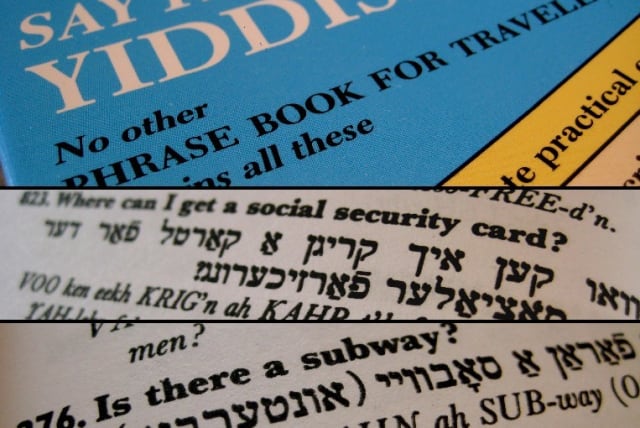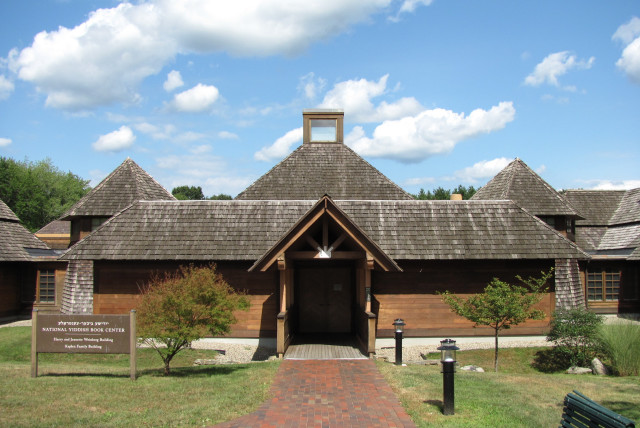Yiddish book center unveils new core exhibit

How do you tell the story of a language without a country, and of a culture that lost a majority of its purveyors in a little over a decade of madness?
Since its opening in 1997, the Yiddish Book Center has wowed visitors with its architecture. A Jewish village resurrected on a college campus in sylvan Amherst, Massachusetts, the building conveys the Center’s mission: to rescue and revive a language spoken for over 1,000 years by Ashkenazi Jews in German-speaking lands, Eastern Europe and wherever they migrated.
On Oct. 15, the Center is unveiling a new core exhibit, meant to flesh out and deepen the story told by its building and the treasures stored inside. Arriving at a moment when Yiddish is experiencing one of its periodic revivals, “Yiddish: A Global Culture” is a major Yiddish institution’s answer to a question without easy answers: How do you tell the story of a language without a country, and of a culture that lost a majority of its purveyors in a little over a decade of madness?
About the exhibit
In response, the new exhibit depicts the “secular” Yiddish culture that arose in the mid-19th century as a distinctly transglobal, modern movement that includes theater, the press, mass market publishing and intellectual ferment in big cities from Warsaw to New York to Shanghai.
The exhibit is “foregrounding a story of creativity, tremendous accomplishment and tremendous diversity of a culture that has migration built into its DNA,” David Mazower, the Center’s research bibliographer and the exhibition’s chief curator, told me when I visited Amherst last month.
The displays in the exhibit will surround and weave in and out of the Center’s book stacks, another striking architectural feature of the building. The stacks offer duplicates of the Center’s collection of 1.5 million Yiddish books and periodicals, for sale and browsing. I couldn’t be the first visitor to be reminded of the closing scene in “Raiders of the Lost Ark,” which reveals a colossal government warehouse filled with, in the words of the screenplay, “crates and crates. All looking alike. All gathering dust.”
What a casual visitor might not see is all that is happening at the Center to blow the dust off those books, including translator workshops, summer fellowships, conferences, an oral history project, a busy publishing program and a riotous summer music festival.
Interest in all of those activities has been helped along by young Jews interested in the language and culture and a pandemic that created a demand for online Yiddish classes. The Yiddish Book Center has been drawing 10,000 visitors a year since its pandemic shutdown. The New York Times made the latest revival official (to non-readers of the Jewish media, anyway) in an essay last month by the Jewish polymath Ilan Stavans, declaring that “Yiddish Is Having a Moment.” Stavans notes a flurry of new translations of obscure and classic Yiddish writers, the all-Yiddish staging of “Fiddler on the Roof” and the Yiddish dialogue in three recent Netflix series: “Shtisel,” “Unorthodox” and “Rough Diamonds.”
(More controversially, Stavans also reports that Yiddish is appealing to those — presumably young anti-Zionist Jews — for whom Hebrew “symbolizes far-right Israeli militarism.”)
Such a revival also challenges keepers of the flame — not just the Yiddish Book Center, but the YIVO Institute for Jewish Research in New York, The Workers Circle, publications like In geveb and the Yiddish Forward, academic departments plus a host of regional Yiddish organizations — to define a language and culture that means many different things to many different people.
History of a language
Is it a language of a decimated past? A progenitor of the Jewish left? A tongue, still spoken daily by haredi Orthodox Jews, that continues to grow and evolve? Is it an attitude — a Jewish way of being and thinking — that survives in humor and cooking and music even if those who appreciate it can’t speak the language?
For European Jews of the Enlightenment, the Yiddish scholar Jeffrey Shandler reminded me a few years ago, “Yiddish represented the resistance and inability of Jews to enter the cultural mainstream. It represented something atavistic, a way of holding Jews back.” For Zionists, meanwhile, it represented a weak Diaspora and everything associated with it (a clash explored in a current YIVO exhibit, “Palestinian Yiddish: A Look at Yiddish in the Land of Israel Before 1948”).
Goldie Morgenthaler, herself the daughter of the Yiddish writer Chava Rosenfarb, has written that she teaches Yiddish literature to mostly non-Jewish university students in Alberta, Canada because “studying what is specific to one culture is often the first step to understanding many cultures.”
At YIVO, an institution founded by scholars in Vilna in 1925 and transplanted to New York in 1940, Yiddish is regarded as an expression of and vehicle for “Jewish pride,” according to its executive director and CEO, Jonathan Brent.
“For Jewish people in the Diaspora to understand that they have in fact a future as Jews,” he said last week, “they have to take pride in their heritage. For all kinds of historical reasons, many Jews felt that [Yiddish] was somehow a shameful or devalued heritage. It was ‘zhargon’ [jargon], and it had been basically eliminated from public discourse in the land of Israel. YIVO from the very beginning wanted to study Yiddish as a language among languages, the same way you studied Russian or Spanish or French. It was a language with a history.
“What Yiddish does,” he continued, “is help anchor us in the language in which our grandparents and great grandparents communicated their deepest thoughts and feelings. And that has real implications for the survival of the Jewish people.”
Aaron Lansky, the founder and president of the Yiddish Book Center, said the story he wants to tell goes back to his days as a graduate student in Yiddish at McGill University in the 1970s, when he first started saving the discarded books that would become the core of the Center’s collection.
“People think of [Yiddish] as this nostalgic creation,” he said. “But the truth is, it was a profound, multifaceted and really global literature that emerged in the late 19th century, and then just took off throughout the 20th century…. It wasn’t long before writers were using every form of literary expression — expressionism, impressionism, surrealism, eroticism. It all found expression in this very short period of time, and even the Holocaust didn’t destroy it. “
Lansky admits his own vision is more literary than the core exhibit’s, and thanked Mazower for creating a broader view of Yiddish as a global culture.
That view is represented in a 60-foot mural that serves as an introduction to the exhibit. Cartoons by the German illustrator Martin Haake depict key historical vignettes in Yiddish history, from nearly every continent. Glikl of Hameln, a German-Jewish businesswoman, writes her diaries at the turn of the 18th century. Women call for a strike at “Yanovsky’s Cigarette Factory” in Bialystok, Poland, in 1901. A nursery scene honors the leading Yiddish activists who were born in Displaced Persons camps after World War II. And tubercular Yiddish writers are seen recovering at the Jewish Consumptive Relief Society in Denver, Colorado, which operated from 1904 to 1940.
The mural lines the ramp that leads to the bookshelves, where displays (some of which Mazower calls “wedges”) use artifacts and wall-mounted photos to talk about the breadth of Yiddish culture. There’s a display about Yiddish celebrities, including writers, such as Sholom Aleichem and Chaim Zhitlowsky, who would draw tens of thousands of mourners to their funerals. Another display honors those who preserved and studied Yiddish culture, from YIVO (described here as “The Mothership”) to the monumental “Language and Cultural Atlas of Ashkenazic Jewry” undertaken between 1959 and 1972 by the linguist Uriel Weinreich. A Yiddish linotype machine, rescued by Lansky, anchors an exhibit about the Jewish press.
A centerpiece of the core exhibit is a recreation of the Warsaw literary salon of the writer and playwright I.L. Peretz, a leading figure of the late 19th century and early 20th centuries. While few actual artifacts belonging to Peretz survive, the room will include contemporaneous objects and photographs to immerse visitors in the literary scene of the day.
“You’ll step through his doorway the way that so many young writers did, clutching their first manuscripts to show them either in Hebrew or in Yiddish,” Mazower explained. “His name, his address was known throughout the Russian Empire at that time. People would come thousands of miles in some cases to Warsaw to try and get entry into this alchemy-like space where extraordinary things happen.”
One of those pilgrims was Mazower’s great-grandfather, the famed playwright Sholem Asch. When Asch showed Peretz a draft of his notorious play “God of Vengeance,” whose lesbian subplot would shock audiences and rile religious leaders, Peretz reportedly told him to burn it.
“My hope is that through the exhibition as a whole you see Jewish history through a Yiddish lens and in a different way from the Holocaust-defined story that so many of us have been educated with and that popular culture feeds us,” said Mazower.
The exhibit treats the Holocaust as one part of the Yiddish story, not its culmination. The original Yiddish edition of Elie Wiesel’s “Night,” published as part of a memorial project in Argentina shortly after the war, rests in a wedge about individuals who rescued Yiddish culture under the Nazis. The same section features a tribute to Rokhl Brokhes, a writer murdered in the Minsk Ghetto in 1945. A still from a recent animated adaptation of one of her stories by Alona Bach, currently a PhD student at MIT focusing on the “intersections of electricity and Yiddish,” affirms one of the Center’s aims: to bring young Yiddishists into conversation with the past.
The story of Yiddish theater will wrap around the auditorium, starting with a large photo of the audience at the opening of the Grand Street Theatre in New York in 1905. A memorial section remembers the probably thousands of actors, playwrights and musicians who were killed in the Holocaust.
“Had Yiddish theater not suffered a rupture, which it did, it would have continued to evolve and borrow and expand,” said Lisa Newman, the Center’s director of publishing and public programs. “What’s so important about this exhibition is that it places Yiddish in this context of language no less than any other country’s, except it’s not a country.”
I asked Mazower what kind of stories he did not want to tell about Yiddish culture.
“It’s not a story about Yiddish humor,” he said. “It’s not a story about the Holocaust. It’s not a story about the state of Israel. It’s not a lachrymose story about Jewish persecution through the ages.”
Other Yiddishists told me much the same thing (Brent said that the story of Yiddish “shouldn’t be told as a collection of jokes, or Yiddish curses, or as a cute language that connects you to Bubbe’s gefilte fish”).
And yet, said Lansky, “We’re not feinschmeckers, we’re not elitist when it comes to Yiddish. Yiddish was a vernacular language, and I am happy to embrace that. I love the humor and social criticism that’s embedded in it. It’s the aggregate that’s so impressive. To see all of this literature and culture in a lively and accessible way can be quite transformative.”
Jerusalem Post Store
`; document.getElementById("linkPremium").innerHTML = cont; var divWithLink = document.getElementById("premium-link"); if (divWithLink !== null && divWithLink !== 'undefined') { divWithLink.style.border = "solid 1px #cb0f3e"; divWithLink.style.textAlign = "center"; divWithLink.style.marginBottom = "15px"; divWithLink.style.marginTop = "15px"; divWithLink.style.width = "100%"; divWithLink.style.backgroundColor = "#122952"; divWithLink.style.color = "#ffffff"; divWithLink.style.lineHeight = "1.5"; } } (function (v, i) { });

